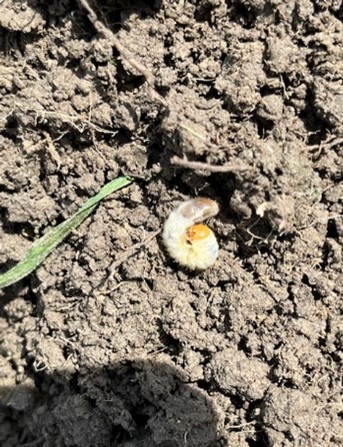Managing Japanese Beetles
This information is provided by the Russell Township Environmental and Sustainability Advisory Committee to help you make informed decisions on the management of Japanese Beetles around your property in urban areas of the Township.
What is a Japanese beetle?
 Japanese beetle (Popillia japonica) is an invasive plant pest that was first introduced to eastern North America from Japan in 1916. The adults are active flyers, but natural spread is slow and they are not able to travel long distances on their own. These beetles may move long distances as hitchhikers on plant material, in roots or soil, or even on cars, trains or planes. Federal efforts are underway to minimize the human assisted spread of this insect to new areas.
Japanese beetle (Popillia japonica) is an invasive plant pest that was first introduced to eastern North America from Japan in 1916. The adults are active flyers, but natural spread is slow and they are not able to travel long distances on their own. These beetles may move long distances as hitchhikers on plant material, in roots or soil, or even on cars, trains or planes. Federal efforts are underway to minimize the human assisted spread of this insect to new areas.
How does it damage plants?
Adult Japanese beetles eat leaves, flowers and fruit. They can significantly damage your plants, vegetable gardens and agricultural crops. The larvae feed on the roots of turf and other plants and can seriously damage your lawns.
Types of plant it thrives on
Japanese Beetles feed, for example, on the following:
- Trees: Maple, poplar, fruit, oak, willows, elder, elm
- Plants: butterfly bush, thistle, daylily, hibiscus, hop, hydrangea, impatient, lilacs, basil, mint, gooseberry, rhubarb, raspberry, blackberry, blueberries, grapes, maize, potatoes, tomatoes, spinach, and others.
How can you control beetles on your property?
 As grubs (larva stage), the beetles live in grass where they eat the roots. At this stage, they are susceptible to a fatal disease caused by a bacteria known as milky spore. This control method is available in a powder form for application on grass at any time. However, it may take 2-4 years before maximum protection is achieved.
As grubs (larva stage), the beetles live in grass where they eat the roots. At this stage, they are susceptible to a fatal disease caused by a bacteria known as milky spore. This control method is available in a powder form for application on grass at any time. However, it may take 2-4 years before maximum protection is achieved.
For maximum effectiveness, you could also use at the same time soil dwelling nematodes which seek out and prey on beetle grubs during the subterranean phase of their life cycle. This product should be applied early morning or early evening to avoid direct sunlight, in the spring or early fall. Applying to a moist soil is best.
Both of these products (milk spore and nematodes) can be found in local hardware stores or nurseries.
Once you see the Japanese beetles, you can control small numbers by using a soap-water spray or hand-pick them and drown them. DO NOT SQUASH THEM AS THAT PROCESS RELEASES HORMONES WHICH ATTRACT MORE BEETLES.
Other methods used such as traps using plastic bags/containers with a pair of crossed walls are baited with a floral scent or pheromone. These scents attract the beetles but unfortunately many of the beetles attracted to the trap end up on plants in the vicinity of the trap causing more damage than if there were not trap at all. The presence of Japanese Beetles also attracts additional Japanese Beetles and are therefore not as effective in controlling the number of beetles in the region.
What is Russell Township doing about this problem?
The Township is in the process of reviewing what it can do on its properties to minimize the volume of Japanese Beetles in the region.
Managing Japanese beetles is challenging but possible with a strategic and sustained effort. By combining various non-chemical methods, homeowners can reduce the impact of these pests on their gardens and lawns.
